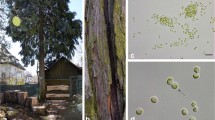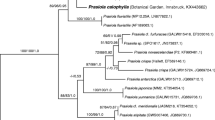Abstract
In this study, the filamentous green alga Zygogonium ericetorum (Zygnematales, Chlorophyta), collected at its natural habitat in the high alps, was investigated by light, scanning, and transmission electron microscopy. The field samples were separated into a moist fraction when wetted by splattering water of a nearby spring or a desiccated one when visually dried out. Light microscopy demonstrated a purple pigmentation of the sun-exposed upper layers, the central position of the nucleus, and the starch content in the pyrenoids. The smooth surface of the cells occasionally covered with fungal hyphae was shown by scanning electron microscopy. The cytoarchitecture of moist cells revealed many vacuoles and only a thin cytoplasmic area surrounding the two chloroplasts. The secondary cell walls of older cells were up to 4 µm thick. Organelle membranes as well as thylakoid membranes occasionally showed an inversion of contrast. In the chloroplasts, distinct areas with granular content surrounding the pyrenoids were detected. Within the cytoplasm, electron-dense particles with electron-translucent crystalloid structures were observed. When desiccated samples were investigated, the vacuoles and cytoplasmatic portions appeared destroyed, whereas nucleus and chloroplasts generally remained intact. The thylakoid membranes of desiccated samples showed lumen dilatations and numerous plastoglobules. Water-soluble extracts were separated by high-pressure liquid chromatography that revealed two major compounds with UV-absorbing capacities.






Similar content being viewed by others
References
Allen A, Alston RE (1959) Formation of purple pigment in Spirogyra pratensis cultures. Nature 183:1064–1065. doi:10.1038/1831064b0
Alpert P (2006) Constraints of tolerance: why are desiccation-tolerant organisms so small or rare? J Exp Biol 209:1575–1584. doi:10.1242/jeb.02179
Alston RE (1958) An investigation of the purple vacuolar pigment of Zygogonium ericetorum and the status of “algal anthocyanins” and “phycoporphyrins”. Am J Bot 45:688–692. doi:10.2307/2439506
Austin II Jr, Frost E, Vidi PA, Kessler F, Staehelin LA (2006) Plastoglobules are lipoprotein subcompartments of the chloroplast that are permanently coupled to thylakoid membranes and contain biosynthetic enzymes. Plant Cell 18:1693–1703. doi:10.1105/tpc.105.039859
Bischoff HW, Bold HC (1963) Phycological studies IV. Some soil algae from enchanted rock and related algal species. Univ Texas Publ No 6318: 1–95
Brook AJ, Johnson LR (2002) Order Zygnematales. In: John DM, Whitton BA, Brook AJ (eds) The freshwater algal flora of the British Isles. Cambridge University Press, Cambridge, pp 479–593
Büdel B (2002) Diversity and ecology of biological crusts. Prog Bot 63:386–404
Büdel B (2005) Microorganisms of biological crusts on soil surfaces. In: Buscot F, Varma A (eds) Soil biology, vol. 3, microorganisms in soils: roles in genesis and functions. Springer, Berlin, pp 307–323
Fritsch FE (1916) The morphology and ecology of an extreme terrestrial form of Zygnema (Zygogonium) ericetorum (Kuetz.), Hansg. Ann Bot (Lond) 30:135–149
Gärtner G (1996) ASIB—the culture collection of algae at the Botanical Institute of the University at Innsbruck (Austria), catalogue of strains 1996. Ber Nat Med Verein Innsbruck 83:45–69
Gau B (1934) Beiträge zur Morphologie und Biologie von Zygogonium ericetorum. B Sporn, Buchdruckerei und Verlagsgesellschaft, Zeulenroda
Gerstberger P, Leins P (1978) Rasterelektronenmikroskopische Untersuchungen an Blütenknospen von Physalis philadelphica (Solanaceae)—Anwendung einer neuen Präparationsmethode. Ber Dtsch Bot Ges 91:381–387
Gray DW, Lewis LA, Cardon ZG (2007) Photosynthetic recovery following desiccation of desert green algae (Chlorophyta) and their aquatic relatives. Plant Cell Environ 30:1240–1255. doi:10.1111/j.1365-3040.2007.01704.x
Holzinger A (2000) Aspects of cell development in Micrasterias muricata (Desmidiaceae) revealed by cryofixation and freeze substitution. Nova Hedwigia 70:275–288
Holzinger A (2009) Desiccation tolerance in green algae: implications of physiological adaptation and structural requirements. In: Hagen KN (ed) Algae: nutrition, pollution control and energy sources. Nova Science, Hauppauge in press
Holzinger A, Lütz C (2006) Algae and UV irradiation: effects on ultrastructure and related metabolic functions. Micron 37:190–207. doi:10.1016/j.micron.2005.10.015
Holzinger A, Karsten U, Lütz C, Wiencke C (2006) Ultrastructure and photosynthesis in the supralittoral green macroalga Prasiola crispa (Lightfoot) Kützing from Spitsbergen (Norway) under UV exposure. Phycologia 45:168–177. doi:10.2216/05-20.1
Holzinger A, Kawamura E, Wasteneys GO (2009) Strategies for microtubule visualization in plants. In: Gavin RH (ed) Methods in molecular biology, cytoskeleton methods and protocols, 2nd edn. The Humana, Totowa in press
Hoppert M, Reimer R, Kemmling A, Schröder A, Günzl B, Heinken T (2004) Structure and reactivity of a biological soil crust from a xeric sandy soil in central Europe. Geomicrobiol J 21:183–191. doi:10.1080/01490450490275433
Kiermayer O (1968) The distribution of microtubules in differentiating cells of Micrasterias denticulata Bréb. Planta 83:223–236. doi:10.1007/BF00385332
Körner C (2003) Alpine plant life: functional plant ecology of high mountain ecosystems. Springer, Berlin
Lagerheim G (1895) Über das Phycoporphyrin, einen Conjugatenfarbstoff. Videnskab. Selsk. Skrifter I. Math Nat Kl 5:3–13
Lynn R, Brock TD (1969) Notes on the ecology of a species of Zygogonium (Kütz) in Yellowstone National Park. J Phycol 5:181–185. doi:10.1111/j.1529-8817.1969.tb02600.x
McCourt RM, Karol KG, Bell J, Helm-Bychowski KM, Grajewska A, Wojciechowski MF, Hoshaw RW (2000) Phylogeny of the conjugating green algae (Zygnemophyceae) based on rbc L sequences. J Phycol 36:747–758. doi:10.1046/j.1529-8817.2000.99106.x
Meindl U (1987) Zellentwicklung und Ultrastruktur der Desmidiacee Pleurenterium tumidum. Nova Hedw 45:347–373
Moore JP, Le NT, Brandt WF, Driouich A, Farrant JF (2009) Towards a systems-based understanding of plant desiccation tolerance. Trends Plant Sci 14:110–117. doi:10.1016/j.tplants.2008.11.007
Nienow JA (1996) Ecology of subaerial algae. Nova Hedwigia Beih 112:537–552
Nishizawa M, Yamagishi T, Nonaka G-I, Nishioka I, Ragan MA (1985) Gallotannins of the freshwater green alga Spirogyra sp. Phytochemistry 24:2411–2413. doi:10.1016/S0031-9422(00)83053-8
Pickett-Heaps (1972) Cell division in Klebsormidium subtlissimum (formerly Ulothrix subtilissima) and its possible phylogenetic significance. Cytobios 6:167–183
Pope CR, Pyatt FB (1984) Aspects of the ecology of Zygogonium ericetorum (Kütz) Hansg. on China-clay tips. Int J Environ Stud 23:217–227. doi:10.1080/00207238408710157
Remias D, Lütz C (2007) Characterisation of esterified secondary carotenoids and of their isomers in green algae: a HPLC approach. Algol Stud 124:85–94
Remias D, Lütz-Meindl U, Lütz C (2005) Photosynthesis, pigments and ultrastructure of the alpine snow alga Chlamydomonas nivalis. Eur J Phycol 40:259–268. doi:10.1080/09670260500202148
Remias D, Holzinger A, Lütz C (2009) Ultrastructure and physiological characterization of the ice alga Mesotaenium berggrenii (Zygnemaphyceae, Chlorophyta) from glaciers in the European alps. Phycologia (in press)
Trainor FR, Gladych R (1995) Survival of algae in a desiccated soil: a 35-year study. Phycologia 34:191–192
Transeau EN (1933) The genus Zygogonium. Ohio J Sci 33:156–162
Tschaikner A, Ingolić E, Holzinger A, Gärtner G (2007) Phycobionts of some species of Evernia and Ramalina. Herzogia 20:53–60
Tschaikner A, Gärtner G, Kofler W (2008) Coelastrella aeroterrestrica sp. nov. (Chlorophyta, Scenedesmoideaea)—a new, obviously often overlooked aeroterrestrial species. Algol Stud 128:11–20
Vaughn KC, Ligrone R, Owen HA, Hasegawa J, Campbell EO, Renzaglia KS, Monge-Najera J (1992) The anthocerote chloroplast: a review. New Phytol 120:169–190. doi:10.1111/j.1469-8137.1992.tb05653.x
Viceré M, Farrant JM, Driouich A (2004) Insights into the cellular mechanisms of desiccation tolerance among angiosperm resurrection plant species. Plant Cell Environ 27:1329–1340. doi:10.1111/j.1365-3040.2004.01212.x
Wesley-Smith J (2001) Freeze-substitution of dehydrated plant tissues: artefacts of aqueous fixation revisited. Protoplasma 218:154–167. doi:10.1007/BF01306605
Ytterberg AJ, Peltier JB, van Wijk KJ (2006) Protein profiling of plastoglobules in chloroplasts and chromoplasts. A surprising site for differential accumulation of metabolic enzymes. Plant Physiol 140:984–997. doi:10.1104/pp.105.076083
Acknowledgement
We would like to thank Werner Kofler from the Department of Systematics, Palynology and Geobotany, Institute of Botany for the expert technical help in performing the SEM studies. Access to the TEM of the Zoology Department, University of Innsbruck is kindly acknowledged. We thank Prof. Cornelius Lütz for critically proofreading the manuscript. This study was supported by a research grant from the “Universitätszentrum Obergurgl” to AH. The authors declare that they have no conflict of interest.
Author information
Authors and Affiliations
Corresponding author
Additional information
Dedicated to Professor Cornelius Lütz on the occasion of his 65th birthday
Rights and permissions
About this article
Cite this article
Holzinger, A., Tschaikner, A. & Remias, D. Cytoarchitecture of the desiccation-tolerant green alga Zygogonium ericetorum . Protoplasma 243, 15–24 (2010). https://doi.org/10.1007/s00709-009-0048-5
Received:
Accepted:
Published:
Issue Date:
DOI: https://doi.org/10.1007/s00709-009-0048-5




